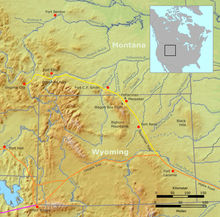Fort Reno (Wyoming)
Fort Reno | |
 Old Fort Reno | |
| Location | Johnson County, East of Sussex on Powder River |
|---|---|
| Nearest city | Sussex, Wyoming |
| Coordinates | 43°49′39″N 106°14′24″W / 43.82750°N 106.24000°W |
| Built | 1865 |
| Architectural style | Fort |
| NRHP reference No. | 70000672 |
| Added to NRHP | April 28, 1970 |
Fort Reno also known as Fort Connor or Old Fort Reno, was a wooden
Establishment
One of the primary goals of the
Army units with the column included Companies L, and M, of the
On August 15, 1865, Colonel Kidd's column selected the site of the fort on a bluff above the Powder River near the crossing of the
Renaming
The Bozeman Trail, built as a way around the Bighorn Mountains, crossed the Powder River at Fort Connor, offering emigrants traveling on it protection. Buildings constructed at Connor had sod-covered roofs and dirt floors. In October 1865, the 6th Michigan and Colonel Kidd turned the garrison of Fort Connor over to Captain George W. Williford, and Companies C, and D, of the 5th United States Volunteer Infantry Regiment, companies of the Galvanized Yankees, and a company of Indian scouts.
In November 1865, its name was changed to Fort Reno, in honor of

Reinforcement
On June 28, 1866
The newly arrived Regular Army soldiers of the 18th Infantry constructed a log stockade around the unprotected garrison buildings, complete with log bastions on the northwest and southeast corners. They also built a sturdy adobe commanding officer's quarters. In 1867, the post was renovated and expanded. The garrison ranged from 125 to a high of 300 soldiers. The second battalion of the 18th Infantry, which was renamed the 27th United States Infantry Regiment in 1867, endured the routines of garrison life and the harsh winters and hot summers, occasionally skirmishing with hostile Indians and keeping the southern end of the Bozeman Trail open and passable.[1]
Abandonment
In 1868 the
Garrison
- August—October 1865 - 6th Michigan Volunteer Cavalry(4 Companies): Colonel James H. Kidd
- October 1865—April 1866 - 5th United States Volunteer Infantry (2 Companies): Captain George W. Williford; Company A, Omaha and Winnebago Scouts: Captain Edwin R. Nash
- April—June 1866 - 5th United States Volunteer Infantry (2 Companies): Captain George M. Bailey
- June—September 1866 - 18th United States Infantry (3 Companies): Captain Joseph L. Proctor
- September 1866—August 1868 - 27th United States Infantry (3 Companies): Captain Joseph L. Proctor
- March 1876 - 4th United States Infantry (2 Companies): Captain Edwin M. Coates
Fort Reno today

The parade ground and surrounding area has generally returned to a natural prairie sod cover. The site, approximately 12 miles (19 km) northeast of Sussex, Wyoming, was listed on the National Register of Historic Places on March 28, 1970. There is a large stone monument and several interpretive signs marking the site that are accessible by a gravel road.[2]
Other Fort Renos
Two other army posts were also named Fort Reno—one
References
- ^ a b c Robert A. Murray (1968). Military posts in the Powder River country of Wyoming, 1865-1894. University of Nebraska Press. p. 189. Retrieved 19 August 2012.
- ^ .Fort Reno, Fort Phil Kearny, archived from the original on July 17, 2012, retrieved August 19, 2012
Photo gallery
-
Fort Reno Monument
-
Fort Reno with Powder River in background
-
Ruins of a building at Fort Reno





